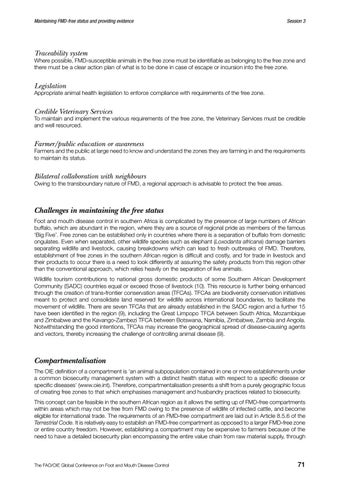Maintaining FMD-free status and providing evidence
Session 3
Traceability system Where possible, FMD-susceptible animals in the free zone must be identifiable as belonging to the free zone and there must be a clear action plan of what is to be done in case of escape or incursion into the free zone.
Legislation Appropriate animal health legislation to enforce compliance with requirements of the free zone.
Credible Veterinary Services To maintain and implement the various requirements of the free zone, the Veterinary Services must be credible and well resourced.
Farmer/public education or awareness Farmers and the public at large need to know and understand the zones they are farming in and the requirements to maintain its status.
Bilateral collaboration with neighbours Owing to the transboundary nature of FMD, a regional approach is advisable to protect the free areas.
Challenges in maintaining the free status Foot and mouth disease control in southern Africa is complicated by the presence of large numbers of African buffalo, which are abundant in the region, where they are a source of regional pride as members of the famous ‘Big Five’. Free zones can be established only in countries where there is a separation of buffalo from domestic ongulates. Even when separated, other wildlife species such as elephant (Loxodanta africana) damage barriers separating wildlife and livestock, causing breakdowns which can lead to fresh outbreaks of FMD. Therefore, establishment of free zones in the southern African region is difficult and costly, and for trade in livestock and their products to occur there is a need to look differently at assuring the safety products from this region other than the conventional approach, which relies heavily on the separation of live animals. Wildlife tourism contributions to national gross domestic products of some Southern African Development Community (SADC) countries equal or exceed those of livestock (10). This resource is further being enhanced through the creation of trans-frontier conservation areas (TFCAs). TFCAs are biodiversity conservation initiatives meant to protect and consolidate land reserved for wildlife across international boundaries, to facilitate the movement of wildlife. There are seven TFCAs that are already established in the SADC region and a further 15 have been identified in the region (9), including the Great Limpopo TFCA between South Africa, Mozambique and Zimbabwe and the Kavango-Zambezi TFCA between Botswana, Namibia, Zimbabwe, Zambia and Angola. Notwithstanding the good intentions, TFCAs may increase the geographical spread of disease-causing agents and vectors, thereby increasing the challenge of controlling animal disease (9).
Compartmentalisation The OIE definition of a compartment is ‘an animal subpopulation contained in one or more establishments under a common biosecurity management system with a distinct health status with respect to a specific disease or specific diseases’ (www.oie.int). Therefore, compartmentalisation presents a shift from a purely geographic focus of creating free zones to that which emphasises management and husbandry practices related to biosecurity. This concept can be feasible in the southern African region as it allows the setting up of FMD-free compartments within areas which may not be free from FMD owing to the presence of wildlife of infected cattle, and become eligible for international trade. The requirements of an FMD-free compartment are laid out in Article 8.5.6 of the Terrestrial Code. It is relatively easy to establish an FMD-free compartment as opposed to a larger FMD-free zone or entire country freedom. However, establishing a compartment may be expensive to farmers because of the need to have a detailed biosecurity plan encompassing the entire value chain from raw material supply, through
The FAO/OIE Global Conference on Foot and Mouth Disease Control
71
















